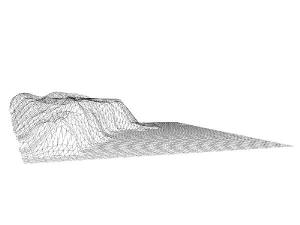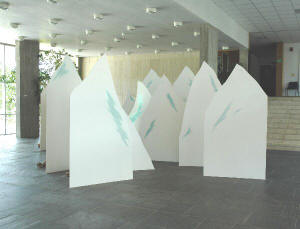|
artcornwall |
|||
| home - features - exhibitions - profiles - gazetteer - links - archive | |||
|
Sovay Berriman, Jacqueline Knight & Patrick Lowry Installation, Sculpture, Print New County Hall, Truro, Cornwall 31st May – 10th June 2006
An atrium in a
city council headquarters is a difficult setting for installation and sculpture.
For a start, the space used by Sovay Berriman, Jackie Knight and Patrick Lowry
at the New County Hall in Truro is a sort of thoroughfare. Every five minutes
besuited council workers march across the floor looking neither right nor left.
To create the
screen prints (Bassets Cove, 2006 (pictured above) and Chapel Porth, 2006) Knight
has used 3D wireframe software to interpret information from scanned
photographs.
At first glance
Sovay Berriman’s Scheme (2006) could be a table-top scale model of the
council building, yet it is a charming escapist fantasy at the heart of the
institution. In the spirit of Jim Lambie, Berriman has used cheap, low-tech
household materials to create a landscape on the top of a dented metal desk.
Washing powder Alpine peaks are fringed with plastic yellow Rawlplug trees.
Could they also be figures, an army advancing in formation? Kneeling down to
take a child’s eye view of the desk top I see how the deliberately careful
arrangement of Rawlplugs embodies control, yet the vulnerability of the flimsy
materials and the precariously balanced powder also suggests imminent collapse.
In a similar way, Pass (2006 -pictured left above) mixes a playful childlike façade with illusions of grandeur. Fifteen white boards are cut into whipped-cream peaks at head height and are arranged in an overlapping formation, so that the “pass” is a zigzagging path between them. Blue glitter streaks on the boards give it a touch of fairground pizzazz, but moving back again through the formation you see untreated plywood behind, a reminder that this game requires an imaginative leap from the viewer. I did not feel the thrill of fear as apaches watched from the valley tops, but I did enjoy the impish appeal to my inner eye. Patrick Lowry’s Blue Lift (2006 - pictured right above) appears to be a metal framework with a pulley system that seems to both support the building’s walkway above it and sink into the ground beneath. The structure, painted a 1980s municipal blue, is actually made of wood. This redundant “machinery” may point to the many disused tin mine sites in Cornwall which now form part of the heritage trail. Where they were once an essential part of an indescribably noisy industrial process they are now silent enigmatic features in the landscape. Each of the artists have attempted to reimagine landscape, both as it is incarnated in the realms of memory and fantasy and how it is hinted at through symbolic reference. Physical place may reside outside of us but within us a sense of place undergoes metamorphosis. It is warped, muted or amplified selectively, according to our will.
Megan Wakefield July 2006
|
|||

